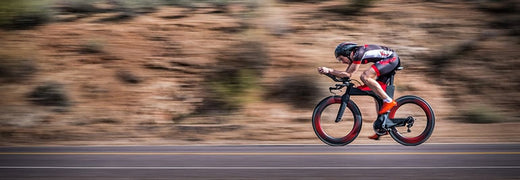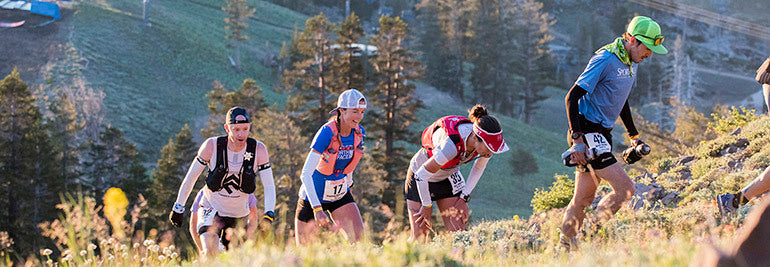

Suunto Blog

D.I.E.T (disaster imminent every time?), and three unchanging principles of nutrition for athletes
What’s the difference between eating healthy and eating right? For athlete, entrepreneur, coach and nutrition expert Dr. Rick Kattouf II this question cuts right to the heart of the debate on nutrition.
“There is a huge difference between eating healthy and eating right,” Kattouf says. “There is a huge difference between feeding the body and fuelling the body. I tell people to stop eating healthy, and they freak out.”
Rick has designed his own line of nutritional supplements. © Rick Kattouf
An example of what Kattouf calls a healthy meal is grilled chicken on a bed of greens, or a bowl of vegetables, beans with a little tofu. While Kattouf agrees these meals are healthy, he says that doesn’t make them right. Eating right is another matter.
Kattouf has credentials to back up his perspective on nutrition for athletes: during four years of pre medicine study and four years of studying optometry he learned about human physiology, pharmacology and biochemistry. The three-time age group national duathlon champion and all-round fitness freak has the performance experience to back up his approach, too.
“There’s a lot of people out there chasing one diet after the next, and one thing I am is an anti diet guy,” Kattouf says. “I trademarked the acronym for the word diet: disaster imminent every time®. That’s what a diet is. My nutrition principles haven’t changed since I was at college. And now I’m 47. Reason being is that human physiology is human physiology.”
Rick Kattouf’s unchanging principles of nutrition
Photo by Danielle Cerullo on Unsplash
When Kattouf starts coaching a new athlete he always asks the same three questions: what time of day do they get out of bed, what time of day they work out and what time do they go to bed. Being clear about this is where a proper nutrition plan begins.
“But what do most people try to focus on? Calories. It’s not about calories in and calories out. It’s all about three key principles: the proper fuelling frequency, the proper fuelling timing, and the right balance of carbohydrates, protein and fat in every meal and snack.”
Photo by Brian Erickson on Unsplash
1. The right ratio
Whether it’s a pro athlete, an age group runner or a morbidly obese person he’s coaching, Kattouf sticks to the same basic meal principle; each meal should consist of about 50 to 60 percent carbohydrates, around 15 to 25 percent protein and between 15 to 25 percent fat.
“For decades we’ve been living with this concept of a higher protein, lower carb diet,” he says. “The carbs have got the dunce hat on and have been shoved into the corner. But what is the only food that the brain can use as fuel? It’s sugars, glucose, carbs, and when we cut those out we’re going to reduce mental acuity, and not get the results we want.”
He says it’s this proper balance of “C-P-F” that plays an important role in stabilising blood sugar, reducing sharp spikes and drops, and helping the body reload. They also help to assist in repairing muscle damage, building muscle, cartilage and bone. These are “macronutrients”, meaning the body needs a large amount of them (and in the right balance) compared to micronutrients like vitamins and minerals.
“There are three things we are going to ask ourselves before every meal or snack: what is my carb, what is my protein, what is my fat. If we can answer all three of those we are moving in the right direction,” Kattouf says
2 & 3. Fuelling frequency and timing
These two are separate, but closely connected. The proper frequency is about how often to eat throughout the day. For optimal performance Kattouf says every two and a half to three hours upon the first snack at waking.
“Fuel your body immediately upon waking, not 30 minutes after, not 60 minutes after, immediately upon waking and then every two to three hours thereafter throughout the day, depending on your goals,” Kattouf says.
The proper timing is about fuelling before, during and after a workout. Having a well balanced snack immediately before a workout and one immediately after is a good start. Especially for endurance athletes, fuelling during is equally important.
Rick’s quick and easy balanced meal
2/3 cup oats1 slice whole grain bread1 TBSP peanut butter3 egg whites
Breakdown:
457 calories52% carbohydrate23% protein25% fat
READ MORE
FUELLING THE ENGINE: A COMMONSENSE APPROACH TO NUTRITION
FUELLING THE ENGINE: TALKING NUTRITION WITH ULTRA RUNNER LUCY BARTHOLOMEW
FUELLING THE ENGINE: TALKING NUTRITION WITH TRIATHLETE MEL HAUSCHILDT
FUELLING THE ENGINE: TALKING NUTRITION WITH TRAIL RUNNER EMELIE FORSBERG
Lead photos by rawpixel and Eaters Collective on Unsplash

The data rules! A pro triathlete’s data driven training approach
When Cody Beals became a triathlete cycling was his weakest discipline. At high school, he was a District All Star in cross country, and a good swimmer. But cycling wasn’t his thing.
The reverse is now true – cycling is his strongest discipline. And it was a data driven approach to his training that made the difference.
For proof, the 28-year-old from Guelph, Ontario won two full distance Ironmans, the first and second of his career. At his first, Ironman Mont Tremblant, he set the bike course and overall course records.
“I undertook a deliberate process of figuring out how to get my cycling up to a world class level,” Beals says. “The biggest thing was getting a power meter – it was a huge revelation! I was wasting so much time on the bike just soft pedalling. With a power meter I learned to make every minute of my riding count.”
© Welle Media
Beals has always been a data freak. He was top of his class at high school, and top of a prestigious physics programme while at university. Back then, he began capturing and analyzing data almost obsessively.
“I made my own monster spreadsheet to track every single last aspect of my life,” he says. “My sleep, my mood, my training – everything. That was when I was a self coached athlete. Even though I was making mistakes, a data approach was always something I believed in.”
After university, Beals has worked in statistics and data analysis, and is using his mastery of these skills to optimise his training. His coach, David Tilbury-Davis, shares a data based training philosophy, and the two work together on that basis. All Beals’s swim, bike and run training is measured and monitored. “The data tells the most compelling story,” he says.
Data analysis has also helped Beals in other ways. Having a Suunto 9 to capture his training runs shows Beals what’s really going on with this runs, not just what he thinks – two very different things. Perceived exertion doesn’t necessarily equate to good performance.
“I've learned through data that how you feel about something sometimes bares no relation to how you're actually performing,” Beals explains. “How I'm feeling is another data point, but it's not the most important. In the absence of power, pace or heart rate data you're just left guessing. The coach can provide part of the reality check, the rest of the reality check comes from these devices and the data they collect.”
© Welle Media
While how he feels about a workout isn’t the most important factor, conversely it is a potentially telling data point. Feeling over the moon isn’t necessarily a good sign, while feeling average isn’t always a bad one.
“I like that the Suunto 9 will prompt you for how you're feeling after each workout, he says. “That's something I have started monitoring more closely. What I've learned is that in a lot of my best training blocks, with almost every single workout, I will feel very medium.
“People assume if you're crushing it leading up to an Ironman, you're feeling great about every session, or maybe some people would assume you are so tired and fatigued that every session is brutally hard.
“The reality is that when I'm putting in my best training blocks, I'm just very stable. Everyday is pretty unremarkable. I'm not putting up epic training sessions. My mood isn't swinging around wildly. It's just day in day out consistency.”
This and other insights help Beals and his coach from avoiding overtraining syndrome, which Beals says is too often a badge of honour in the world of triathalon.
“It's kind of celebrated when athletes can push themselves to extreme lengths in training, but I will tell you that any moron can overtrain themselves,” Beals says. “The hard part is the deliberate, methodical application of training load and on the flip side recovery to reach your true potential.”
Lead image: © Ventum
READ MORE:
SLAYING HIS DEMONS: A PRO TRIATHLETE’S JOURNEY TO FINDING BALANCE

Fuelling the engine: talking nutrition with Emelie Forsberg
For an increasing number of people today nutrition isn’t only a question of what food we eat, it’s also about where that food has come from and how it’s been produced.
When she's not in the mountains, you can find Emelie in her garden or preparing delicious meals. © Matti Bernitz
Eating seasonally
For Swedish mountain running champion Emelie Forsberg sustainability plays an important role in her decision making around diet. For this reason Forsberg eats seasonally. “In the winter, for example, I try not to buy fruit or anything transported from far away places,” she says. “For me, the seasons are something to go through.”
Fall, she says, is a time to begin spending more time indoors, thinking, reading and reflecting, slowing down after the summer. Winter, Forsberg says, is a time for taking care of oneself, resting, and recharging. Spring is a time of awakening, coming out of hibernation, and using more energy. Summer is a time of fun and intensity.
Forsberg eats different foods during each season. “I really enjoy eating in the winter,” she says. “For breakfast, I eat porridge with berries on top. I’m living in Scandinavia, and we have many berries and greens, and a lot of herbs. In the winter we eat a lot of potatoes. The best is eating potatoes with olive oil and salt! In summer, we have smoothies, more salads, and colder foods.”
Straight from the earth
Forsberg is also an avid gardener. Her dream is to become as self sufficient as possible. Leafy greens, beans, potatoes, berries, carrots, you name it, Forsberg is growing it. Gardening, working with the earth, being in harmony with the seasons, is a form of spirituality for Forsberg. She believes the fresher it is the better.
© Kilian Jornet
Relaxed eating
Listening to her body is a big part of how she eats, rather than following meal plans. “I never have a meal plan,” she says. “In the beginning you need to get into a routine, but now I don’t even think about it anymore. You just need to use your imagination. Some people get obsessed about eating healthy. I’m not like that. I’m relaxed in the way I’m eating.”
Bean power
She is a big fan of beans, and admits to eating them at least once a day. “Even bean cakes and bean cookies,” she laughs. “Like, everything beans – 10 different types of beans, five different types of lentils! When you are vegetarian it’s important to know where you are getting your protein from.”
Easy, go-to meals
Forsberg stores a lot of food in her freezer, including bean burger patties. If it’s going to be a busy week she’ll make a big meal on Monday and store it to have again later in the week. “I like to have back up meals.
“I also make pesto out of everything, any type of green, even the tops of carrots,” she says. “A bit of garlic, olive oil, sun seed flower, nuts and seeds, and I eat it with pasta. I was eating it with bean pasta just now!
Salad with carrot and lentil patties
Salad (green salad, rocket, carrots, beets, brussels and onion from the garden)
Patties: 3 carrots, grated4 dl of red lentils; slightly cooked, can be a bit hard.1/2 an onion2 tbsp spoon of tahinia little parsleychili, salt and black pepperMix it all together and fry, or bake them in the oven!
Lead image: Photo by Blair Fraser on Unsplash.

Running every single street in San Francisco – and why the math counts
© Max Romey/ Wandering Fever
When Rickey Gates visited his home town in Colorado recently he bumped into a high school friend who ran in the same cross country team. Now assistant professor of aerospace engineering at University of Maryland College Park, Mike Otte’s eyes lit up when Gates told him about his new running project – to run every single street in San Francisco in six weeks.
“I should have known by his reaction right there that this is not a simple problem,” Gates says. “It’s a complicated problem. I’m learning that now.”
Photo by Robert Bye on Unsplash
Like all big cities, San Francisco has a dense grid pattern of streets. The planning challenge is working out how to run them all, while minimising repetition. Get that wrong and the distance quickly increases. Otte has helped calculate and plot the complex route.
The total distance is about 2000 km, not including all the doubling back and forth required for Gates to accomplish running every single street once. Adding to the challenge are San Francisco’s famous hills and crazy streets. So far he’s covered about 650 km and nearly 20000 m of climbing.
“I haven’t even hit the biggest hills and the steepest streets yet,” Gates says. “It’s a big project. I greatly underestimated the challenge of efficient route finding. Hours are spent trying to figure out which way to go. Fun none the less though.”
© Max Romey/ Wandering Fever
Gates got the idea when he came to the end of his epic run across the United States last year. He started in South Carolina and finished in San Francisco, where he has lived off and on for four years. When he ran into the city he realised its immensity.
“It occured to me that knowing a huge country, and to cross it, is one thing, and knowing a city by really immersing yourself in it is a completely different thing,” he says. “That’s when I came up with this idea to run every street in this city I’ve called home.”
To prepare for the project he gained extra weight, which he lost in the first week of running. Into the second week now, pounding the pavement every day is taking a toll on his body. But the hardest thing for Gates is staying patient.
“I have to remind myself it just takes time ticking off the miles,” he says. “The biggest difference between the run across the country and this run is when I started my run across the country I couldn’t see the other side. Every single day here I’m looking at the immensity of this project and it’s important to keep in mind that I hope to do this in about six weeks, and to not get overwhelmed by the size of it.”
© Max Romey/ Wandering Fever
Gates isn’t the first person to run every street in San Francisco. Runners have done the same thing in other cities, too. However, Gates hopes his effort inspires others to get out to explore their cities. His high school running coach has got on board, and is now running all the streets back in his hometown, a total distance of about 320 km.
To encourage people to get out and explore their locality, Gates is going to give away one of his Suunto 9 watches. To have a chance, run every street in your neighborhood, town, city by December 15, and tag Suunto, Salomon and #everysinglestreet on Instagram, and he’ll choose a winner.
“It really opens your eyes to the place you live. I think that’s the most magical part about it.”
Lead image: Photo by Robert Bye on Unsplash

Want to race Western States 2019? Here’s your chance to win an entry!
The Western States 100-Mile Endurance Race is the world’s oldest 100-mile trail trace race, bringing hundreds of athletes together each year to navigate the challenging route across the Sierra Nevada Mountains, from Squaw Valley to Auburn, California. With over 18,000 feet of climbing and nearly 23,000 feet of descent, the race has become one of one of the ultimate tests of endurance in the world.
“Western States is one of the most highly regarded ultramarathons in the world and we are honored by the opportunity to connect with a wonderful race community,” says Suunto Americas Marketing Manager Caleb Whittle.
“Given Suunto’s heritage in navigation as well as the ongoing success of our Suunto 9 sports watch, this partnership is an ideal fit,” says Caleb.
In the Suunto 9, Western States athletes have one of the ultimate timepieces available to ultra-distance runners. Highlights of the Suunto 9 include customized battery settings and 120-hour battery life, as well as the unique FusedTrack technology, which improves GPS accuracy while extending battery life.
What does the ultra-running community mean to you?
As the exclusive sports watch sponsor for the California event, we will grant one lucky winner a coveted place at the 2019 start line and a Suunto 9 watch through the fan-generated #SuuntoUltraCommunity contest, which runs through November 8 – 27, 2018.
To participate in the contest, Western States hopefuls should post a photo on Instagram, Facebook or Twitter with a caption describing what the community of ultra-running means to them, along with the hashtag #SuuntoUltraCommunity. In order to qualify, all entrants must meet all requirements to run the Western States 100, including having finished a qualifying race and applied for the lottery by November 10, 2018. The winner will be announced at the lottery drawing on December 1, 2018.
All images by: Luis Escobar
Social Media Terms and Conditions
There is no purchase necessary to enter this contest; however, participant must be willing to pay the race entry fee ($450USD) upon announcement (see wser.org for more information)
By entering this competition, an entrant is indicating his/her agreement to be bound by these terms and conditions.
The contest will be run on Instagram, Facebook, and Twitter
Only one entry will be accepted per person.
The contest is open to citizens of the Fifty United States and the District of Columbia, Denmark, Germany, Spain, France, Norway, Finland, Sweden, United Kingdom, Russia, Canada (excluding the province of Quebec) Japan, Australia, Austria and New Zealand.
Closing date for entry will be November 27, 2018. After this date the no further entries to the competition will be permitted.
No responsibility can be accepted for entries not received for whatever reason.
The rules of the competition and how to enter are as follows:
Post an image on Instagram, Facebook, or Twitter of your interpretation of the community of ultra-running
In the caption/description, explain what the community of ultra-running means to you
Tag @Suunto and use the hashtag #SuuntoUltraCommunity
Suunto reserves the right to cancel or amend the competition and these terms and conditions without notice in the event of a catastrophe, war, civil or military disturbance, act of God or any actual or anticipated breach of any applicable law or regulation or any other event outside of the promoter’s control. Any changes to the competition will be notified to entrants as soon as possible by the promoter.
Suunto is not responsible for inaccurate prize details supplied to any entrant by any third party connected with this competition.
The prize is as follows: One (1) entry into the 2019 Western States 100-Mile Endurance Run and one (1) Suunto 9 Watch.
The prize is as stated and no cash or other alternatives will be offered. The prizes are not transferable. Prizes are subject to availability and we reserve the right to substitute any prize with another of equivalent value without giving notice.
The winner will be chosen by a panel of Suunto employees
The winner will be announced live during the Lottery drawing on December 1, 2018 and on the WSER website no later than 2pm PST on the same day.
Suunto’s decision in respect of all matters to do with the competition will be final and no correspondence will be entered into.
By entering this competition, an entrant is indicating his/her agreement to be bound by these terms and conditions.
The competition and these terms and conditions will be governed by United States of America law and any disputes will be subject to the exclusive jurisdiction of the courts of the United States of America
The winner agrees to the use of his/her name and image in any publicity material, as well as their entry. Any personal data relating to the winner or any other entrants will be used solely in accordance with current US data protection legislation and will not be disclosed to a third party without the entrant’s prior consent.
Entry into the competition will be deemed as acceptance of these terms and conditions.
This promotion is in no way sponsored, endorsed or administered by, or associated with, Facebook, Twitter or any other Social Network. You are providing your information to Suunto and not to any other party.
Suunto shall have the right, at its sole discretion and at any time, to change or modify these terms and conditions, such change shall be effective immediately upon posting to this webpage.

Fuelling the engine: a commonsense approach to nutrition
Eating well is essential for athletes. The bigger your goal, the more nutrition has to play a central part of your training plan. Take shortcuts on how you eat, and you’ll eventually pay for it.
But the topic of diet, what we should and shouldn’t eat, has become touchy and confusing. There are all sorts of diets out there – paleolithic, vegan, gluten-free, low carb, high carb – each one with advocates claiming their way is the one true way.
Matias Anthoni prefers a common sense approach to nutrition.
“Nowadays it’s become a big topic, and everyone has his or her own opinion, and it seems hard to find the real truth,” says Matias Anthoni, Suunto’s in-house personal trainer. “It’s become trendy to follow a kind of diet.”
Anthoni, 26, has a Bachelor in Sports and Health Promotion, and gives nutritional advice to Suunto employees, as well as personal fitness training. He takes a simple, “nonsectarian” approach to nutrition, rather than buying into the hype of one diet over another.
“As long as you get the nutrients it doesn’t really matter what diet you follow,” he says. “You can teach your body to thrive on different diets. The body is quite adaptable. But we do need certain basics. The question I always ask is, would my grandma recognize it as food?”
Here are Anthoni’s five down-to-earth tips for good nutrition:
1. Start with your meal rhythm
This is the first topic Anthoni’s raises with his clients during a consultation. Just improving how often you eat can improve what you eat. Many of his clients skip meals or have long breaks between meals; this results in blood sugar levels dropping, then tiredness, and then cravings and impulses for unhealthy snacks.“With a more steady meal rhythm you avoid big spikes in the blood levels, make better decisions, and are less likely to just reach for a chocolate bar,” he says.
Meals should be about three hours apart, and consist of a good breakfast, lunch and dinner, with smaller, healthy snacks in between. “It leads to healthier choices and you’ll have more energy,” Anthoni says.
2. Plan ahead
“You can’t be a top athlete if you are eating poorly; it’s not just about training, it’s about eating as well,” Anthoni says. “It really helps if you plan your meals like you plan your training. Know what you are going to buy and know what you are going to make. When you come home from work, or after a training session, it’s all ready to go.”
3. Follow the Nordic plate model
Anthoni says in Finland there’s a traditional “plate model” or a way to divide your plate into three sections: one half should be salad and vegetables, one quarter should be carbohydrates, and one quarter protein. This balanced plate ensures you will get enough of all the key nutrients.
4. Eat quality food
Quality can seem like a vague notion, so Anthoni recommends a common sense approach here, too. “Have a look at your plate – are there all the colours – red, green, yellow?” he asks. “Are you eating the same thing every day?” Anthoni suggests finding and following basic nutrition guidelines. “They provide a good start, and then make small changes to fit yourself from there,” he says.
5. There’s no one size fits all diet
Deciding what to eat depends on your goals. “The more you move the more you need,” Anthoni says. “If your goal is building muscle mass, then you need more protein. If you are an endurance athlete, eating enough carbohydrates becomes more important. There is no one size fits all, no one plan can fit everyone. You need to have your own plan.”
Lead image: Photo by Roosa Kulju on Unsplash.
READ MORE
Fuelling the engine: talking nutrition with ultra runner Lucy Bartholomew
Fuelling the engine: talking nutrition with triathlete Mel Hauschildt














































































